
Belgian collectors card by Chocolaterie Clovis, Pepinster. Photo: Errol Flynn in Captain Blood (Michael Curtiz, 1935). Collection: Amit Benyovits.

French postcard in the Collection Magie Noire by Éditions Hazan, Paris, 1990, no. 6224. Humphrey Bogart in Casablanca (Michael Curtiz, 1942).
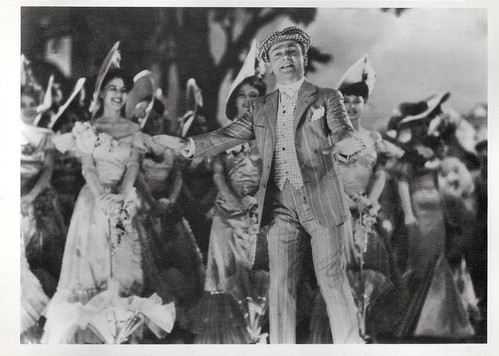
Canadian postcard by Canadian Postcard, no. A-68. Photo: James Cagney in Yankee Doodle Dandy (Michael Curtiz, 1942).
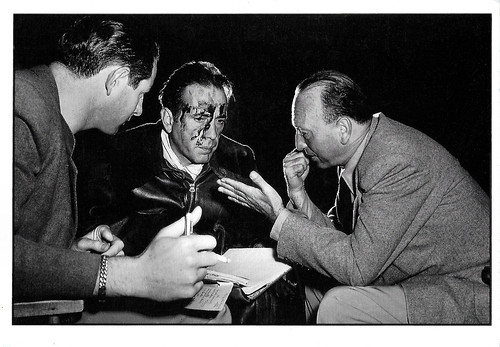
French postcard in the Entr'acte series by Éditions Asphodèle. Mâcon, no. 00/8. Director Michael Curtiz, Humphrey Bogart and scriptwriter Herschel Daugherty on the set of Passage to Marseille (Michael Curtiz, 1944).
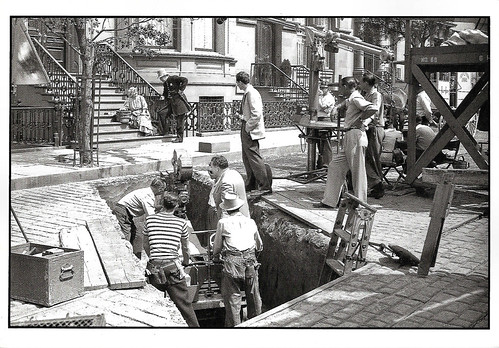
French postcard in the Entr'acte series by Éditions Asphodèle, Mâcon, no. 001/02. Photo: set photo of Life With Father (Michael Curtiz, 1947). Caption: For the purposes of the film, a real pit in a dummy street at Warner Bros. Studios in Burbank.

Dutch postcard by Drukkerij Uitg. Int. Filmpers, Amsterdam, no. 5019. Elvis Presley, Dolores Hart, Carolyn Jones, Liliane Montevecchi and Jan Shepard in King Creole (Michael Curtiz, 1958).
Director of Hungary's first feature film
Michael Curtiz (1886-1962) was born Manó Kaminer in Budapest, Hungary, in 1886. His father was a carpenter and his mother was an opera singer. In 1905, he Magyarised his name to Mihály Kertész. Curtiz became attracted to the theatre when he was a child. He built a little theatre in the cellar of his family home when he was 8 years old, where he and five of his friends re-enacted plays. They set up the stage, with scenery and props, and Curtiz directed them. After graduating from high school, he studied at Markoszy University, followed by the Royal Academy of Theater and Art, in Budapest.
After he graduated from college at age 19, he took a job as an actor with a travelling theatre company, where he began working as one of their travelling players. From that job, he became a pantomimist with a circus for a while but then returned to join another group of travelling players for a few more years. They played Henrik Ibsen and William Shakespeare in various languages, depending on what country they were in. They performed throughout Europe, including France, Hungary, Italy, and Germany, and he eventually learned five languages.
In 1912, Mihály Kertész worked at the National Hungarian Theater. He was also a member of the Hungarian fencing team at the Olympic Games in Stockholm. Kertész directed Hungary's first feature film, Ma és holnap/Today and Tomorrow (Mihály Kertész, 1912), in which he also had a leading role. He followed that with another film, Az utolsó bohém/The Last Bohemian (Mihály Kertész, also 1912).
He went to study at Nordisk studio in Denmark, which led to work as an actor and assistant director to August Blom on Denmark's first multireel feature film, Atlantis (August Blom, 1913), a literary adaptation of Gerhard Hauptmann's 'Atlantis'. Then, he returned to Sweden, where he assisted directors such as Victor Sjöström and Mauritz Stiller, as Scandinavian films dominated European cinemas at the time. After World War I began in 1914, he returned to Hungary, where he served in the army for a year, before he was wounded fighting on the Russian front.
Kertész soon became chief director of the leading Hungarian film production company, Phoenix, where he remained until he left Hungary. In Budapest, he directed more than 40 silent films for the Phoenix until 1919. However, none of the films he directed in Hungary survives intact, and most are completely lost. In 1919, the communist Béla Kun established a short-lived dictatorship in Hungary. With the seizure of power by Kun and his nationalisation of the film industry, Mihály Kertész fled with other Hungarian filmmakers to West Europe to make films there.
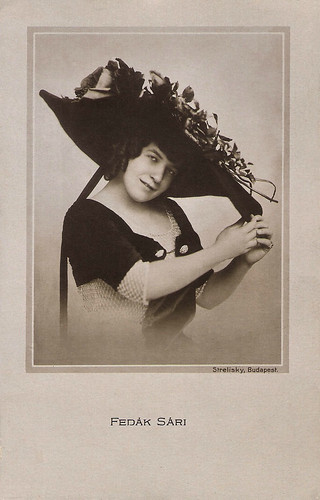
Hungarian postcard by Kiadja Reinitz Jòzsef, Budapest. Photo: Strelisky, Budapest. Hungarian actress and singer Sári Fedák (1879-1955) was one of the most famous prima donnas of her time. She co-starred with Alfréd Deésy in the Hungarian film Rablélek (1913), directed by Mihály Kertész.
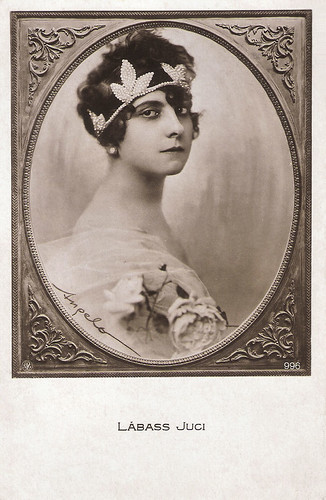
German postcard by NPG, no. 996. Photo: Angelo. Juci Lábass (1892-1932), aka Lucie Labass and Juczi Lábass, was a Hungarian stage and screen actress. In 1915 she made her screen debut at the Hungarian film company Projectograph in Mihály Kertész's film A paradicsom/A Paradise, in which she played a newcomer on the stage, opposite Jenõ Sziklay as a married lawyer. She remained with Kertész for the comedy Doktor úr/Mr. Doctor (Mihály Kertész, 1916), based on a play by Ferenc Molnár. The male leads were Márton Rátkai, Labass' future husband, and György Kürthy.

German postcard by NPG, no. 994. Photo: Angelo, Budapest 1918. Emmi Kosáry (1889-1964) was a Hungarian opera diva and operetta prima donna with a beautiful soprano voice. Kosáry made her film debut in the silent film Tatárjárás/Tartar Invasion (1917) with Camilla von Hollay. The film was directed by Mihály Kertész.

German postcard by Ross Verlag, Berlin, no. 572/1, 1919-1924. Lucy Doraine in Sodom und Gomorrha/Queen of Sin and the Spectacle of Sodom and Gomorrah (Mihály Kertész, 1922).

Romanian postcard. Photo: Dorian-Film. Maria Corda and Adelqui Migliar in Die Sklavenkönigin/The Moon of Israel (Mihaly Kertesz, 1924).
The biggest and most expensive film productions ever made in Austria
Mihaly Kertesz briefly worked at the UFA the famous German film company, where he learned to direct large groups of costumed extras, along with using complicated plots, rapid pacing, and romantic themes. His career truly started when he moved to Austria and continued his work at Count Alexander 'Sascha' Kolowrat's film studio, Sascha-Film. Kertesz made at least 21 films for the count's film studio.
At Sascha-Film, Kertesz tended to specialise in directing two kinds of films, either sophisticated light comedies or historical spectaculars. With such monumental films as Sodom und Gomorrha/Queen of Sin and the Spectacle of Sodom and Gomorrah (Mihály Kertész, 1922) and Die Sklavenkönigin/The Moon of Israel (Mihaly Kertesz, 1924), he realised some of the biggest and most expensive film productions ever made in Austria.
Die Sklavenkönigin/The Moon of Israel (Mihaly Kertesz, 1924) was a spectacle of the enslavement of the children of Israel and their miraculous deliverance by way of the Red Sea. Shot in Vienna with a cast of 5,000, it had for its theme the love story of an Israelite maiden and an Egyptian prince. Paramount Pictures bought the rights to the film in the U.S. to compete with Cecil B. DeMille's The Ten Commandments.
Mihaly Kertesz was in direct competition with his compatriot Alexander Korda, who was also directing monumental films for the rival company Vita-Film at the same time. He also made Red Heels (1925) and Die goldene Schmetterling/The golden butterfly (Michael Curtiz, 1926) starring Lili Damita. He launched the careers of Lucy Doraine and Lili Damita, who both went on to become international stars. Kertesz was a member of the board of the Austrian Film Association, a lobby group for Austrian filmmakers. He worked in Berlin and Paris in the 1920s.
Die Sklavenkönigin/The Moon of Israel (Mihaly Kertesz, 1924) also caught the attention of Jack and Harry Warner. In 1926, Harry went to Europe just to meet Curtiz and watch him work as a director. Harry Warner asked him to come to Hollywood and offered him a well-paid contract at his new film studio, Warner Bros. There he would direct a similar epic that had been planned, Noah's Ark (1928). By the time Kertesz accepted Warner's offer, he was already a prolific director, having made 64 films in countries including Hungary, Austria, and Denmark. With his emigration, he also changed his surname. From now on, he was called Michael Curtiz.
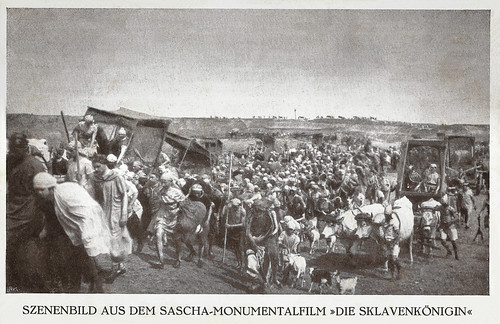
Austrian postcard by Sascha. Scene from Die Sklavenkönigin/The Moon of Israel (Mihaly Kertesz, 1924).

Italian postcard by Edizione E.F.A., no. 937. Photo: Lili Damita in the Austrian silent film Die goldene Schmetterling/The golden butterfly (Michael Curtiz, 1926).

German postcard by Ross Verlag, no. 3866/4, 1928-1929. Photo: F.P.S. Lili Damita in Die goldene Schmetterling/The Golden Butterfly (Michael Curtiz (as Michael Kertesz), 1926).

German postcard by Ross Verlag, no. 4424/1, 1929-1930. Photo: Warner Bros / Nationalfilm. Dolores Costello in Hearts in Exile (Michael Curtiz, 1929).

French postcard by Europe, no. 658. Photo: Warner Bros / Arta Film. Dolores Costello in Noah's Ark (Michael Curtiz, 1929).
The fastest-growing studio in Hollywood
Michael Curtiz arrived in the United States in the summer of 1926 and began directing at Warner Bros. During what became a 28-year period at Warner Bros., he directed 86 films. At 38, he was an experienced filmmaker, but Warners assigned him to direct a number of average-quality films to break him in. The first was The Third Degree (Michael Curtiz, 1926) with Dolores Costello. Wikipedia: "Curtiz's unique camerawork technique was used throughout, visible in dramatic camera angles, in a style which one critic assumed other directors would likely envy."
Warner Bros. began experimenting with sound films. They assigned two part-silent and part-talking pictures for Curtiz to direct: Tenderloin (Michael Curtiz, 1928) and Noah's Ark (Michael Curtiz, 1928), both of which also starred Dolores Costello. Noah's Ark included two parallel stories, one recounting the biblical flood, and the other a World War I-era romance. It was the first epic film attempted by Warner Bros., and in handing production over to Curtiz, they were hoping to assure its success. The climactic flood sequence was spectacular and the story was an adaptation written by Bess Meredyth, who married Curtiz a few years later.
The critical success of the films by Curtiz contributed to Warner Bros' becoming the fastest-growing studio in Hollywood. Curtiz was friends with co-founder Harry Warner, with whom he shared a love of polo and horse breeding. He remained with Warners for the next 26 years and became the studio's most distinguished director. Some of his films were routine productions, but in most of his films, Curtiz was able to demonstrate his technical mastery of constructing interesting scenes even from hackneyed scripts.
In 1930, Curtiz directed Mammy (Michael Curtiz, 1930), Al Jolson's fourth film after being in Hollywood's first true talking picture, The Jazz Singer (Alan Crosland, 1927). Although unusual projects for Warner Bros., Curtiz directed two Horror films for the studio, Doctor X (Michael Curtiz, 1932) and Mystery of the Wax Museum (Michael Curtiz, 1933), both in early Technicolor, with numerous atmospheric scenes filmed on the studio's back lot. During the 1930s, Curtiz directed at least four films each year. Especially in the 1930s and 1940s, Curtiz rose to become a major director at Warner Bros and was a style-setter in many respects.
His films with Errol Flynn, beginning with the Swashbuckler Captain Blood (Michael Curtiz, 1935) based on the novel by Rafael Sabatini, made Flynn from an unknown extra into the studio's biggest male star. The film was a major success with positive critical reviews and a nomination for the Academy Award for Best Picture. Other hits with Flynn and his co-star Olivia De Havilland were The Charge of the Light Brigade (Michael Curtiz, 1936), which depicts a heroic episode from the Crimean War, the Swashbuckler The Adventures of Robin Hood (Michael Curtiz, William Keighley, 1938), which perfectly combined Technicolor and crowd scenes to effective effect, and The Sea Hawk (Michael Curtiz, 1940) with Brenda Marshall instead of De Havilland, became classics of the genre. Later, the successful collaboration broke down due to disputes between the rather undisciplined Flynn and the authoritarian Curtiz.
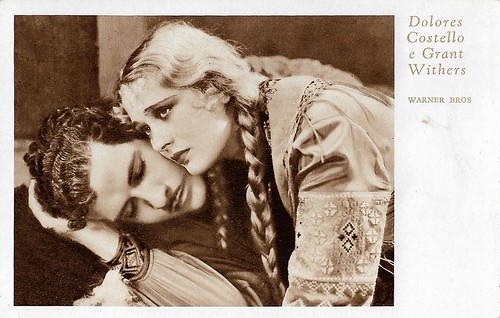
Italian postcard in the Cinema-Illustrazione, series II, no. 8. Photo: Warner Bros. Dolores Costello and Grant Withers in Hearts in Exile (Michael Curtiz, 1929).

British postcard by Film Weekly. Photo: Warner Bros. Lionel Atwill and Edwin Maxwell in the horror film Mystery of the Wax Museum (Michael Curtiz, 1933). It was one of the last fiction films using the two-color Technicolor process. The film would be remade as House of Wax (1953).
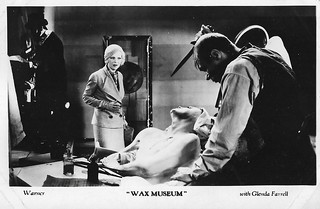
British postcard by Film Weekly. Photo: Warner Bros. Glenda Farrell in the horror film Mystery of the Wax Museum (Michael Curtiz, 1933).

British postcard in the Filmshots series by Film Weekly. Photo: Warner. Margaret Lindsay and William Powell in Private Detective 62 (Michael Curtiz, 1933).

British postcard in the Filmshots series by Film Weekly. Photo: Warner. Sheila Terry and William Powell in Private Detective 62 (Michael Curtiz, 1933).
Warner Bros.'s biggest box-office success in the company's history
The 1940s continued to have releases of other critically acclaimed Michael Curtiz films, including The Sea Wolf (Michael Curtiz, 1941) with his new discovery John Garfield, the World War II-era romantic drama Casablanca (Michael Curtiz, 1942) - one of the most popular films ever made, Mildred Pierce (Michael Curtiz, 1945), and Life with Father (Michael Curtiz, 1947).
Curtiz helped several actors to excellent roles. James Cagney won the Academy Award for Best Actor in a Leading Role at the 1943 Academy Awards for Yankee Doodle Dandy (Michael Curtiz, 1942), the film biography of composer and entertainer George M. Cohan. The film became Warner Bros.'s biggest box-office success in the company's history up to that time, nominated for nine Academy Awards and winning four. The success of the film also became a high point in Curtiz's career, with his nomination as Best Director.
Joan Crawford won the Academy Award for Best Actress in a Leading Role at the 1946 Academy Awards for her performance in Mildred Pierce (Michael Curtiz, 1945). Crawford gave one of the strongest performances in her career, playing a mother and successful businesswoman who sacrifices everything for her spoiled daughter, played by Ann Blyth. Mildred Pierce was nominated for six Academy Awards, including Best Picture. Crawford and Curtiz worked together again in 1949 on The Road to Success.
Curtiz directed William Powell and Irene Dunne in the family comedy Life with Father (Michael Curtiz, 1947). It was a big hit in the United States and was nominated for four Academy Awards, including Best Actor for Powell. During Powell's career, he acted in 97 films. His third and last nomination was for Life with Father (Michael Curtiz, 1947).
Michael Curtiz was responsible for the rise of Doris Day. He first auditioned her and gave her a starring role in her debut film, Romance on the High Seas (1948). Day co-starred with Kirk Douglas and Lauren Bacall in Young Man with a Horn (Michael Curtiz, 1950), with Douglas portraying the rise and fall of a driven jazz musician, based on real-life cornet player Bix Beiderbecke. Curtiz followed with I'll See You in My Dreams (Michael Curtiz, 1952), with Doris Day and Danny Thomas. The film is a musical biography of lyricist Gus Kahn.

Dutch postcard by Takken / 't Sticht, no. a.x. 399. Photo: Warner Bros. Errol Flynn in The Charge of the Light Brigade (Michael Curtiz, 1936).

French postcard by Erpé, no. 611. Photo: Vitagraph. Fredric March in Anthony Adverse (Mervyn LeRoy, Michael Curtiz, 1936).

French postcard, no. 764. Photo: Warner Bros. Errol Flynn in The Adventures of Robin Hood (Michael Curtiz, William Keighley, 1938).
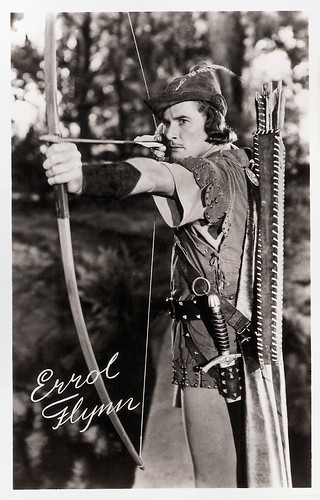
Dutch card. Photo: Warner Bros. Errol Flynn in The Adventures of Robin Hood (Michael Curtiz, William Keighley, 1938).
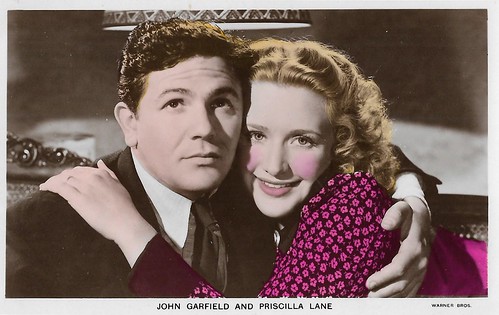
British postcard in the Film Partner series, no. PC 303. Photo: Warner Bros. John Garfield and Priscilla Lane in Four Daughters (Michael Curtiz, 1938).

British postcard by Dover Publications Inc., 1986. Photo: Jeanne Cagney, James Cagney, Joan Leslie, Walter Huston and Rosemary De Camp in Yankee Doodle Dandy (Michael Curtiz, 1942).
A bitter court battle with Warner Bros.
The long partnership between Michael Curtiz and Warner Bros. eventually descended into a bitter court battle. Curtiz left Warner Brothers in 1953. Curtiz continued to direct on a freelance basis from 1954 onwards. For Fox, he made The Egyptian (Michael Curtiz, 1954), based on Mika Waltari's novel about Sinuhe, and starring Jean Simmons, Victor Mature, and Gene Tierney.
Curtiz directed many films for Paramount. White Christmas (Michael Curtiz, 1954), his second adaptation of an Irving Berlin musical, was a major box-office success, even the highest-grossing film of 1954. It starred Bing Crosby, Danny Kaye, Rosemary Clooney, and Vera-Ellen. Another popular film was the crime comedy We Are Not Angels (Michael Curtiz, 1955), starring Humphrey Bogart and Peter Ustinov as gangsters who escaped from prison.
Another success was the musical, King Creole (Michael Curtiz, 1958), with Carolyn Jones and Elvis Presley in one of his few dramatic roles. The final film that Curtiz directed was The Comancheros (Michael Curtiz, 1962). Curtiz was ill during the shoot, but star John Wayne took over directing on the days Curtiz was too ill to work. Wayne did not want to take a co-director credit. The Comancheros was released six months before his death from cancer on 10 April 1962
Around 1918, Michael Curtiz married actress Lucy Doraine, and they divorced in 1923. They had a daughter, Kitty Curtiz-Eberson (1915-2006). He had a lengthy affair with Lili Damita starting in 1925. In 1929, Curtiz married his last wife, actress and screenwriter Bess Meredyth. During their marriage, Curtiz had numerous affairs and Meredyth once left him for a short time but they remained married until his death. She was Curtiz's helper whenever he needed to deal with scripts or other elements which went beyond his grasp of English and he often phoned her for advice when presented with a problem while filming. He had one son, John Meredyth Lucas, whom he adopted in 1929 when the boy was ten years old.
In 1933, Curtiz became a naturalised U.S. citizen. Curtiz had left Europe before the rise of Nazism: other members of his family were less fortunate. He asked Jack Warner, who was going to Budapest in 1938, to contact his family and help them get exit visas. Warner got Curtiz's mother to the U.S., where she spent the rest of her life living with her son. He could not rescue Curtiz's only sister, her husband, or their three children, who were sent to Auschwitz, where her husband and two of the children were murdered. After his death at 75, Michael Curtiz was interred in the Forest Lawn Memorial Park Cemetery in Glendale, California.

Belgian postcard. Photo: Warner Bros. Kirk Douglas in Young Man with a Horn (Michael Curtiz, 1950).
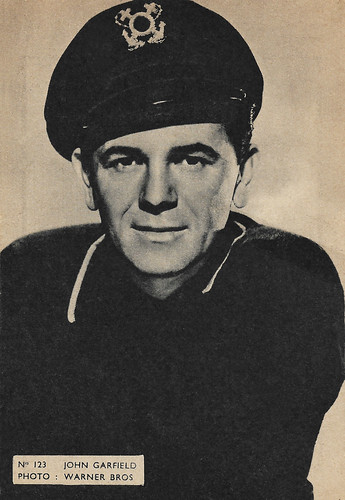
Belgian collectors card by Publesca for Le Cinéma Ritz, no. 123. Photo: Warner Bros. John Garfield in The Breaking Point (Michael Curtiz, 1950).
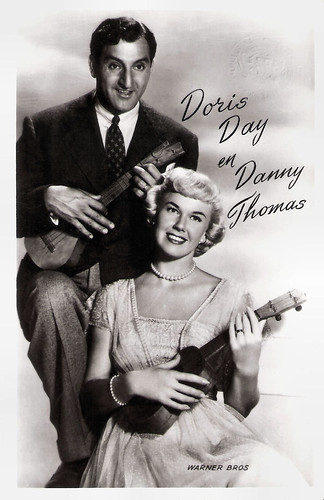
Dutch postcard by Takken, Utrecht, no. 810. Photo: Warner Bros. Doris Day with Danny Thomas in I'll See You in My Dreams (Michael Curtiz, 1951).

French postcard by P.I., Paris, presented by Les Carbones Korès, no. 482. Photo: Warner Bros, 1953. John Wayne in Trouble Along the Way (Michael Curtiz, 1953).

German card by Kolibri-Verlag, no. 1420. Photo: Paramount. Vera-Ellen in White Christmas (Michael Curtiz, 1954).

German postcard by ISV, no. A 27. Photo: 20th Century Fox. Sheree North in The Best Things in Life Are Free (Michael Curtiz, 1956).

Dutch postcard by Uitg. Takken, Utrecht, no. AX 3978. Photo: Paramount. Elvis Presley and Carolyn Jones in King Creole (Michael Curtiz, 1958).
Sources: Wikipedia (German and English) and IMDb.
This post was last updated on 23 April 2023.
No comments:
Post a Comment